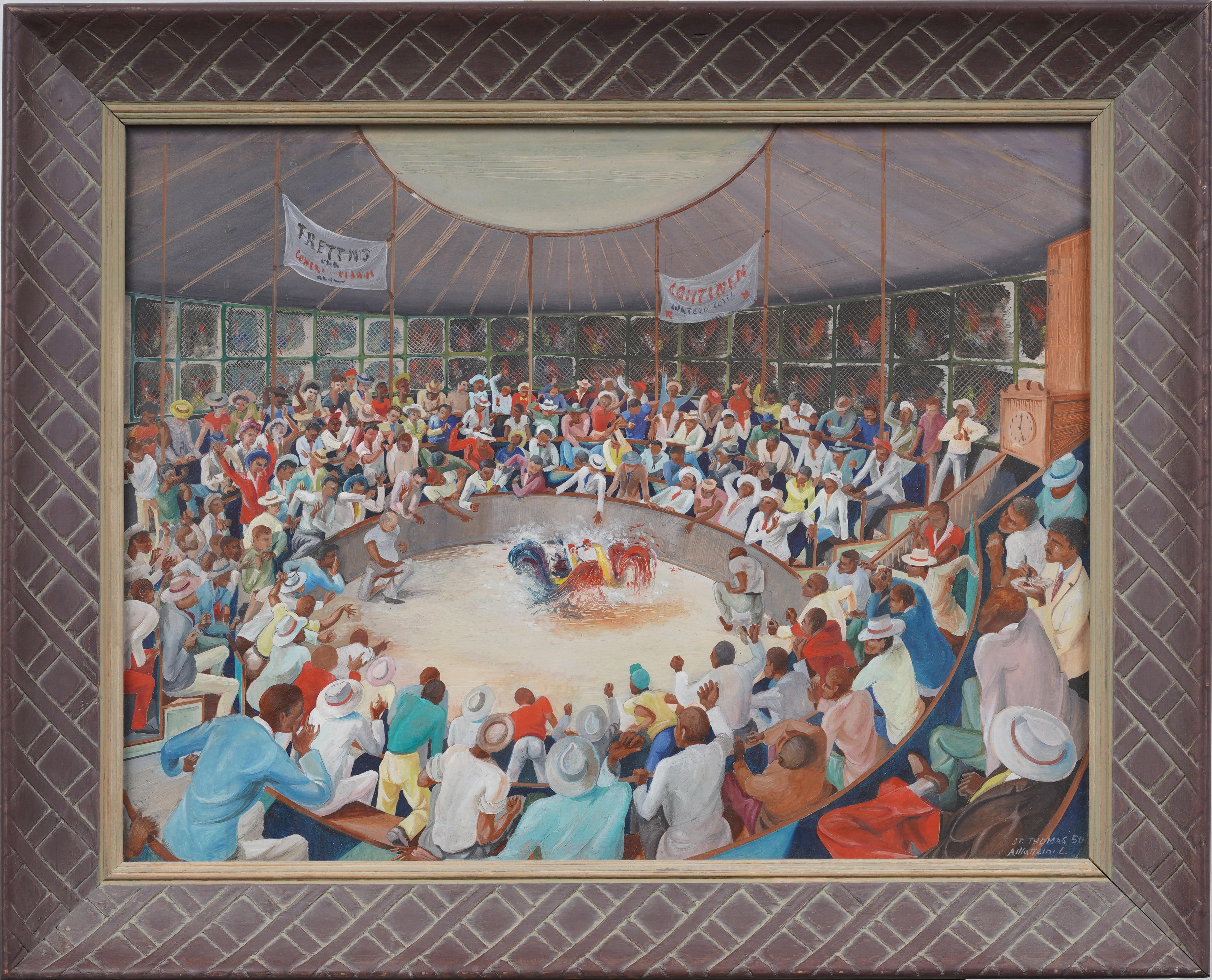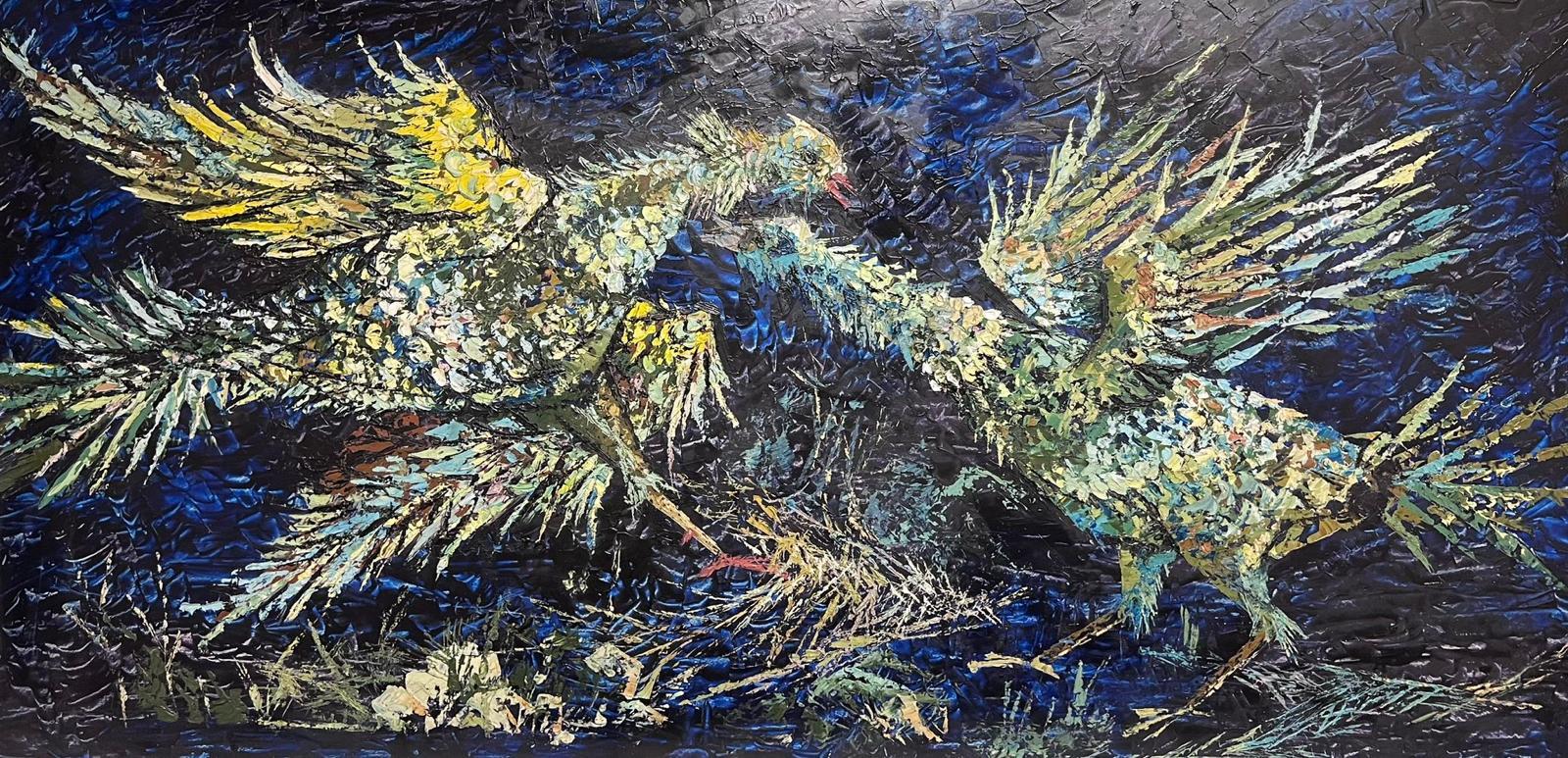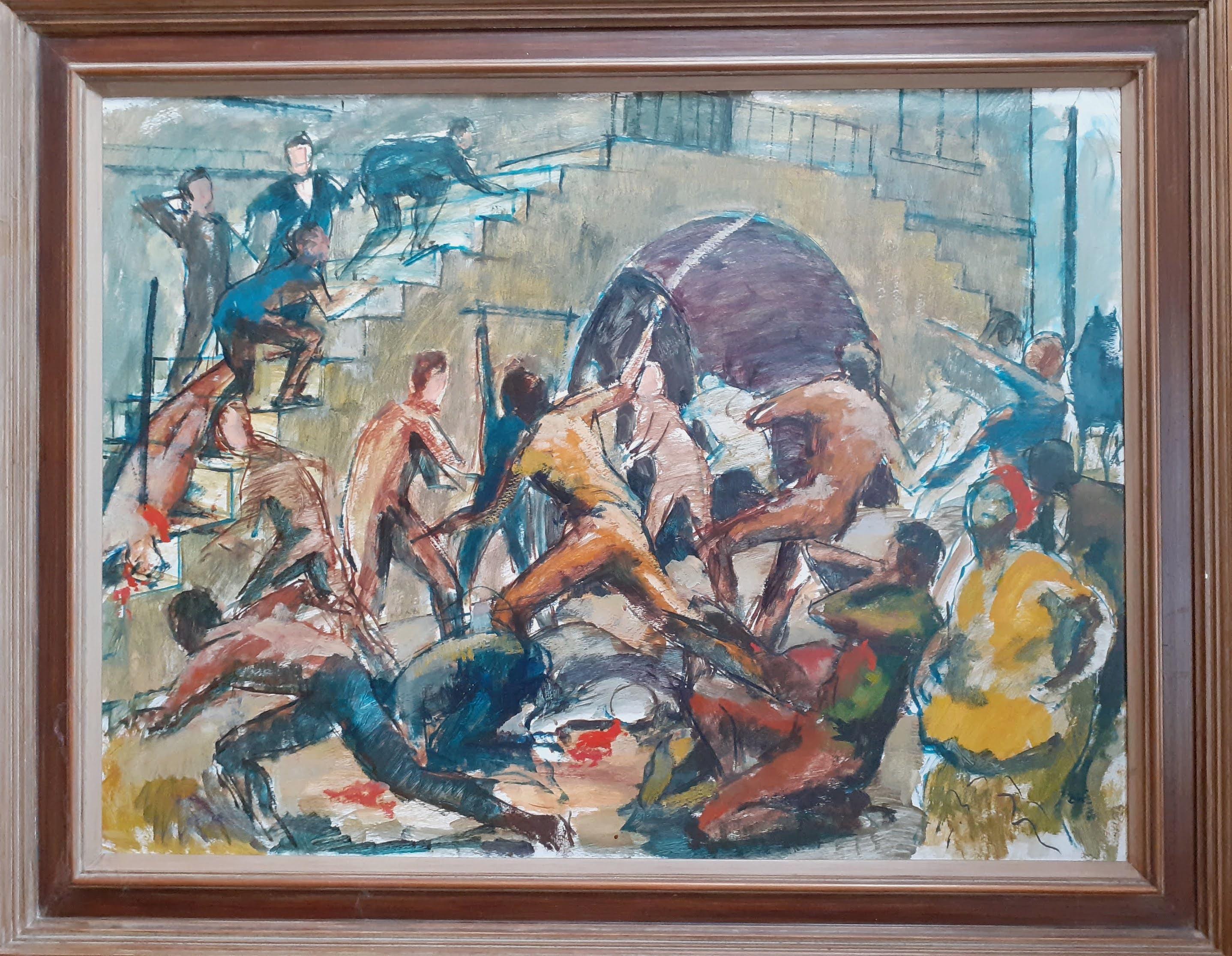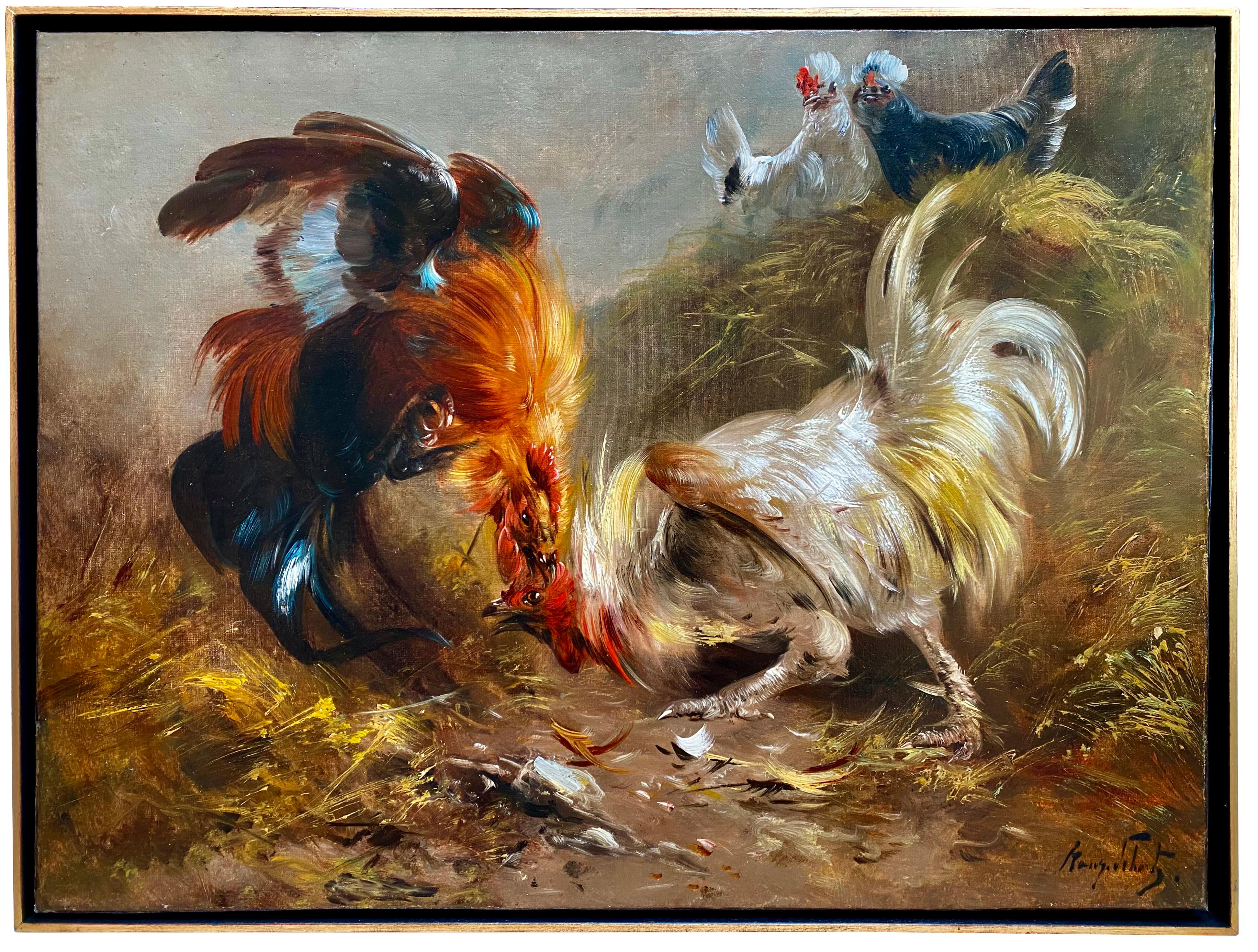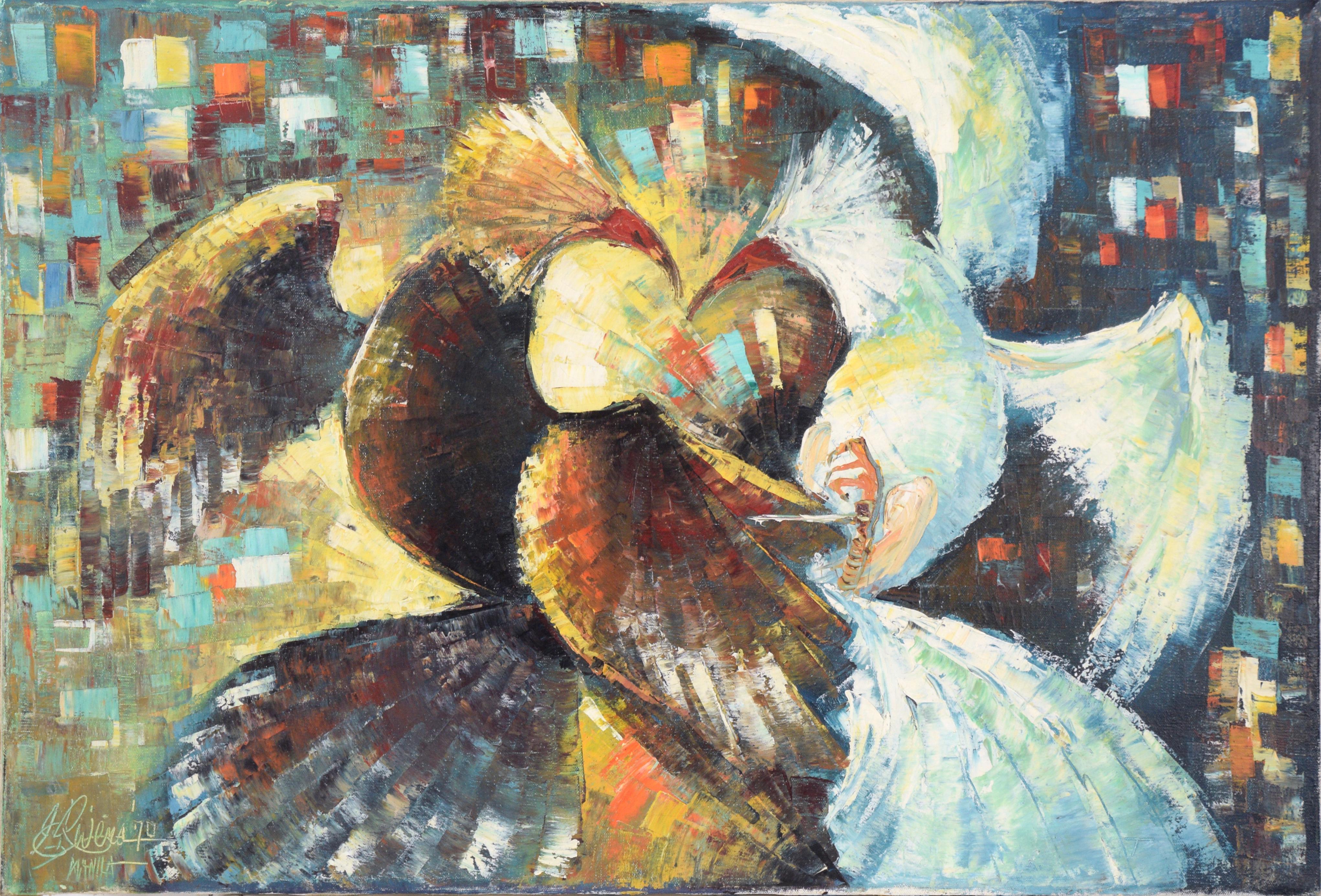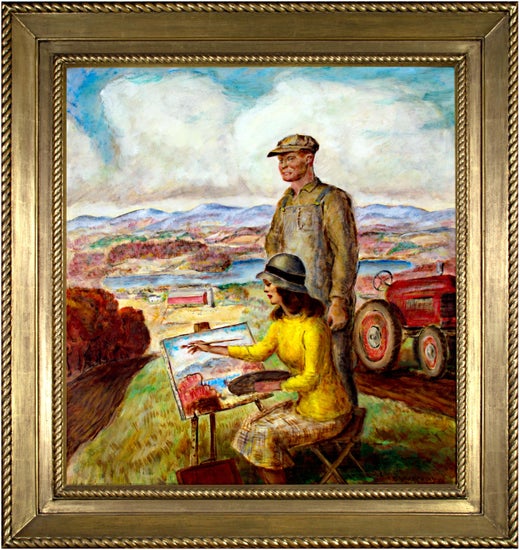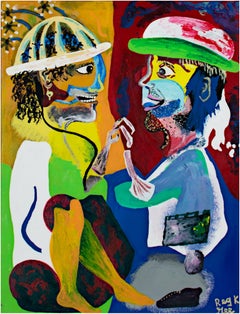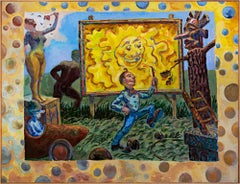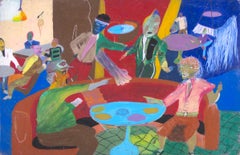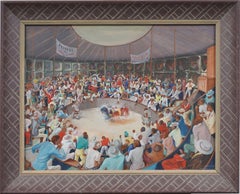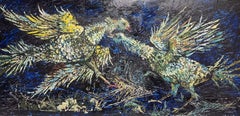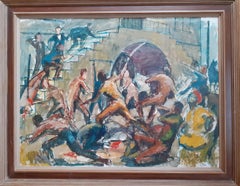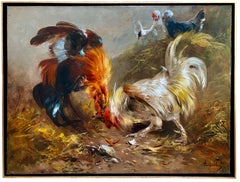Articoli simili a 'Cock Fight in Cuba' original Regionalist painting signed by John Steuart Curry
Vuoi altre immagini o video?
Richiedi altre immagini o video al venditore
1 di 10
John Steuart Curry'Cock Fight in Cuba' original Regionalist painting signed by John Steuart Curry1946
1946
943.508,08 €
Spedizione
Recupero del preventivo…La promessa 1stDibs:
Garanzia di autenticità,
Garanzia di rimborso,
Annullamento entro 24 ore
Informazioni sull’articolo
John Steuart Curry
"Cockfight in Cuba," 1946
oil on canvas
Image: 38.25 x 46.25 in
Frame: 43.75 x 51.5 in
Signed on reverse with initials JSC on lower right stretcher bar
John Steuart Curry (1897-1946), is best-known as one of the American Regionalist artists active during the Great Depression through the World War II era. The Regionalists (including artists Grant Wood and Thomas Hart Benton) distinguished themselves from the abstract art scene during the first part of the Twentieth century by painting typically American subject matter, although Curry’s themes were hardly limited to farms. While born in Kansas on his family’s farm, Curry went on to study art in Chicago, Paris and New York as a young man. In Paris, he was exposed to the work of some of the Old Masters, particularly Rubens, Delacroix, and David. Like these artists, Curry’s major themes and subject matter were the great struggles of life.
One of Curry’s paintings that exemplify this theme of human struggle is Cock Fight in Cuba, which was completed in 1946, the year of his death. Curry spent a little over a month in Cuba in early 1946 in preparation for an advertising campaign for National City Bank, and undoubtedly sketched this scene, as was his method, while traveling in the country. The painting depicts a crowd of suited men in fedoras cheering on two fighting cocks in the foreground. While the men in the crowd gesticulate wildly behind a low wall indicating the barrier of the ring, three men are in the foreground of the painting, inside the ring with the roosters. The two on either side of the fighting animals have their arms extended out as if to hold the crowd back. The third man, in the lower right corner of the painting, is African and his hands reach towards the birds as if to save them, which has the effect of directing the viewer’s gaze at the action. Curry uses the lines created by the arm gestures of the men to bring focus on the drama of the fighting animals.
The colors with which Curry has painted Cockfight in Cuba are also a way that he directs the viewer’s attention and sets a mood for the piece. In the background of the painting, the crowd of men is painted en grisaille, or in shades of gray, which makes the dark brown skin of the African man in the foreground stand out. The bright red of the birds’ cockles and the blood on their feathers are about the only spots of color in the painting. This bit of contrast is very effective in drawing our gaze to the birds, who are themselves nearly a blur of flapping wings. Curry’s painting style in Cockfight is brushy, as if the way he applied the paint was also part of the rather frenzied, dramatic scene. This fact, along with the predominant use of gray in the background, probably led to the incorrect belief that this painting was unfinished at the time of Curry’s death, but we know it is a completed work because the artist’s conception is fully realized. The painting is also signed on reverse with the initials JSC on the lower right stretcher bar. More evidence of the finality of the painting can be found in the fact that preliminary drawings exist for Cockfight in Cuba that are in the collection of the Springfield Museum of Art in Missouri. The composition of the final painting directly reflects what the artist had worked out in the initial drawings.
The subject of fighting animals is one Curry used throughout his career, and most likely grew out of his experiences among animals in his youth on his parents’ farm. Curry witnessed the drama of life and death firsthand and this became to him a great allegory for human struggles. The image of two animals, even two of the same species, fighting to the death, was a symbol of humankind’s simultaneous innate violence and vulnerability.
The more specific symbolism in Cockfight in Cuba, however, is the comparison made by the artist between animal violence and the racial violence of Curry’s time. The horror of seeing the cocks fight to the death is a metaphor for white oppression of and the violence towards blacks in the United States at that time. It was during this era that highly publicized lynching was occurring in the South and America saw resurgence in the Ku Klux Klan. This painting is important because Curry has revealed for the viewer his own moral beliefs. Curry’s social and political views were progressive – he was a member of the National Urban League and was a civil rights activist, whose friends included Wisconsin Governor Robert Lafollette (founder of the Progressive party) and Lloyd Garrison, the famously liberal Dean of the University of Wisconsin Law School while Curry was employed at the University as artist-in-residence. Curry had made political statements in his paintings many times before and some of his most important works centered on subject matter from the African American experience during the early part of the Twentieth century. Examples include The Fugitive (lithograph, 1934-36) and Manhunt (lithograph, 1934), which are both about lynching, and what is arguably Curry’s most important work on this theme, The Freeing of the Slaves (mural, 1942, University of Wisconsin Law Library).
In Cockfight in Cuba, Curry was able to express deeply held beliefs on a subject that was important to him and many other people of his time. Curry believed that, above all, art should have a social significance to the viewer, and the best artists were those that presented current social or ethical issues in their work. By that standard, he would certainly have been pleased with this painting, which uses the event of the cockfight to create a spectacle analogous to horror of a lynch mob. This painting is a wonderful demonstration of how John Steuart Curry used scenes that he observed from life and re-interpreted them on canvas to express a greater moral meaning.
Essay by Monet C. Haskins and David J. Barnett
- Creatore:John Steuart Curry (1897-1946, Americano)
- Anno di creazione:1946
- Dimensioni:Altezza: 111,13 cm (43,75 in)Larghezza: 130,81 cm (51,5 in)
- Tecnica:
- Movimento e stile:
- Periodo:
- Condizioni:
- Località della galleria:Milwaukee, WI
- Numero di riferimento:Venditore: 12845g1stDibs: LU60535197151
John Steuart Curry
Nato a Dunavant, in Kansas, il 14 novembre 1897, John Steuart Curry divenne il membro più giovane del famoso "trio Benton-Woods-Curry" di pittori regionali del movimento della Scena Americana dell'inizio del XX secolo. An si guadagnò una reputazione nazionale per le sue scene rurali del Kansas. L'artista si concentrava su persone con i piedi per terra, che parlavano in modo semplice e autonomo e che si guadagnavano da vivere con un duro lavoro fisico. Curry ha realizzato murales che trattano il tema della colonizzazione e della giustizia razziale e le sue opere che riflettono questi temi si trovano nel Capitol Building in Kansas, nell'Università del Wisconsin, nel Dipartimento degli Interni degli Stati Uniti e nel Dipartimento di Giustizia degli Stati Uniti. L'artista lasciò il liceo e frequentò l'Istituto d'Arte e la Scuola di Design di Kansas City. Si trasferì all'Art Institute di Chicago. Curry sposò Clara Derrick nel 1923. Ha studiato a Parigi nel 1927. Non era impressionato dai pittori modernisti americani, molti dei quali adottavano gli "ismi" degli artisti contemporanei francesi. Curry era determinato a dipingere soggetti americani senza modelli europei e a celebrare il patriottismo, l'orgoglio regionale e l'uomo comune. An He si stabilì a Westport, nel Connecticut. Nel 1928 dipinse Battesimo in Kansas. Il dipinto è stato annunciato a livello nazionale come opera di un nuovo genere americano. È stata esposta alla biennale della Corcoran Gallery of Art dove ha riscosso il favore della critica. Nel 1931, Gertrude Vanderbilt Whitney lo acquistò per il suo museo. Il Tornado sul Kansas fu inaugurato nel 1929, prima del crollo del mercato azionario, e fornì alla città il tema romantico dell'uomo contro la natura. Nel 1933 ha ricevuto il secondo premio alla mostra internazionale di Carnegie. Nel 1930 tenne la sua prima mostra personale al Whitney Studio Club. Le sue opere degli anni '30 contengono i temi del lavoro, della famiglia e della terra, dimostrando la pace, la lotta e la perseveranza che Curry riteneva essere l'essenza della vita americana. Nel 1934 sposò Kathleen Shepard. Il governo degli Stati Uniti lo ha scelto per dipingere murales per il Dipartimento di Giustizia e il Dipartimento degli Interni. Nel 1936 fu nominato Artist-in-Residence presso il College of Agriculture dell'Università del Wisconsin. È stato membro dell'Art Students' League e ha vinto premi tra cui: Premio d'acquisto, North West Print Maker, quinta mostra annuale, 1933; secondo premio, trentunesima mostra internazionale, Carnegie Institute, 1933; medaglia d'oro, PAFA, 1941; premio, Artistics for Victory Exhibition, Metropolitan Museum of Art, 1941. Le mostre includono: "A Celebration of Rural America", 2007, Danville Museum of Fine Arts and History; "Collective Images: the sketchbooks of John Steuart Curry", 2002, Worcester Art Museum; "Illusions of Eden": Visions of the American Heartland", 2000, Columbus Museum of Art; "The American Century: Art and Culture 1900-2000", Whitney Museum of American Art; e "John Steuart Curry: Inventing the Middle West", 1998, M. H. de Young Memorial Museum. Morì a Madison, Wisconsin, nel 1946.
Informazioni sul venditore
4,9
Venditore Platino
Venditori Premium con valutazione 4.7+ e tempi di risposta entro 24 ore
Fondazione nel 1966
Venditore 1stDibs dal 2017
435 vendite su 1stDibs
Tempo di risposta standard: 2 ore
- SpedizioneRecupero del preventivo…Spedizione da: Milwaukee, WI
- Politica di reso
Alcune parti di questa pagina sono state tradotte automaticamente. 1stDibs non può garantire che le traduzioni siano corrette. L’inglese è la lingua predefinita del sito.
Garanzia di autenticità
Nell’improbabile caso in cui si verifichi un problema con l’autenticità di un articolo, contattaci entro un anno per ottenere un rimborso completo. DettagliGaranzia di rimborso
Se il tuo articolo non corrisponde alla descrizione, è danneggiato durante il trasporto o non arriva, contattaci entro 7 giorni per un rimborso completo. DettagliAnnullamento entro 24 ore
Hai un periodo di tolleranza di 24 ore per annullare il tuo acquisto, senza necessità di fornire spiegazioni.Venditori professionali selezionati
I nostri venditori di livello internazionale devono aderire a rigorosi standard di servizio e qualità, garantendo l’integrità delle inserzioni.Garanzia miglior prezzo
Se scopri che un venditore ha pubblicato altrove lo stesso articolo a un prezzo più basso, applicheremo lo stesso prezzo.Consegna globale affidabile
La nostra rete di vettori leader del settore offre opzioni di spedizione specializzate in tutto il mondo, inclusa la consegna personalizzata.Altro da questo venditore
Mostra tutto"Pow-Wow indiano", dipinto a tempera originale firmato da David Barnett
Di David Barnett
"Indian Pow-Wow" è un dipinto originale a tempera, firmato in basso a destra. Presenta contorni gestuali in blu, decorati con sfumature di giallo, blu e verde.
Dimensioni dell'arte:...
Categoria
Anni 1960, Contemporaneo, Dipinti figurativi
Materiali
Tempera
"Footwork at Random - Variation I", acrilico a tecnica mista firmato da Reginald Gee
Di Reginald K. Gee
"Footwork at Random - Variation I" è un dipinto acrilico a tecnica mista su tela di Reginald K. Gee. L'artista ha firmato l'opera in basso a destra. Raffigura due figure che ballano....
Categoria
Inizio anni 2000, Contemporaneo, Dipinti figurativi
Materiali
Tela, Tecnica mista, Acrilico
"Artista a Eliopoli", Acrilico su tela di Randall Berndt
Di Randall Berndt
"Artista a Heliopolis" è un dipinto originale in acrilico di Randall Berndt. Raffigura un artista che salta e alcune altre figure distorte. "Heliopolis", nel titolo del dipinto, potr...
Categoria
Anni 1980, Dipinti figurativi
Materiali
Tela, Acrilico
"Faraway from Familiar Sounds", disegno a pastello a olio firmato da Reginald K. Gee
Di Reginald K. Gee
"Faraway From Familiar Sounds" è un disegno originale a pastello a olio su cartoncino di Reginald K. Gee. L'artista ha firmato il pezzo sul retro. Raffigura una serie di figure astra...
Categoria
Anni 1980, Contemporaneo, Disegni e acquarelli figurativi
Materiali
Pastelli a olio
"El Baile (La danza)", olio su iuta firmato da Ernesto Gutierrez
Di Ernesto Gutierrez (b.1941)
"El Baile (La danza)" è un dipinto originale a olio su iuta di Ernesto Gutierrez. L'artista ha firmato l'opera in basso a destra. Questo dipinto raffigura cinque figure che ballano e...
Categoria
Inizio anni 2000, Dipinti figurativi
Materiali
Olio, Iuta
"Saloon", olio su tavola firmato da Charles Damrow
Di Charles Damrow
"Saloon" è un dipinto originale a olio su tavola firmato e datato in basso a sinistra dall'artista Charles Damrow. Raffigura due cowboy a cavallo con le pistole che mirano al saloon ...
Categoria
Anni 1970, Altro stile artistico, Dipinti figurativi
Materiali
Olio
Ti potrebbe interessare anche
Antico dipinto realista sociale super dettagliato di Thomas Thomas che lotta contro i polli tropicali
Una scena di combattimento di galli vivida e densamente popolata, dipinta nel 1950 e firmata Allatteini L., in basso a destra, con l'iscrizione St. Thomas 50. Questo olio di grandi d...
Categoria
Anni 1950, Moderno, Dipinti (interni)
Materiali
Olio, Tavola
Dipinto a olio modernista degli anni '60: "La lotta dei galli".
Il combattimento tra galli
Scuola francese, anni '60 circa
olio su tavola, incorniciato
incorniciato: 25 x 48,75 pollici
tavola: 24 x 48 pollici
provenienza: collezione privata
condi...
Categoria
Metà XX secolo, Moderno, Dipinti (animali)
Materiali
Olio
Un'enorme attualità sulla schiavitù della Storia Nera pittura Giamaica Morant Bay 1865 ribellione
Uprising - un'enorme e dipinto incredibilmente potente e attuale del maestro giamaicano Barrington Watson (1931-2016).
Raffigura il 1865 La ribellione di Morant Bay, in cui i giam...
Categoria
Anni 1960, Realismo, Dipinti figurativi
Materiali
Masonite, Olio
Lotta tra galli" di Henry Schouten (Batavia, Indonesia 1857 - 1927 Bruxelles)
Henry Schouten
Batavia, Indonesia 1857 - 1927 Bruxelles
Pittore belga
'Lotta tra cazzi'
Una scena dinamica e vivida che cattura due galli nel bel mezzo di un combattimento con le ...
Categoria
Fine XIX secolo, Impressionismo, Dipinti (animali)
Materiali
Tela, Olio
Lotta astratta tra galli Filippine 1970
Luminosa e dinamica rappresentazione di due uccelli che combattono, opera dell'artista filippino JG Rivera (XX secolo). Sprazzi di colore circondano un'esplosione di piume. Al centro...
Categoria
Anni 1970, Impressionismo astratto, Dipinti figurativi
Materiali
Tela, Olio
1301 € Prezzo promozionale
20% in meno
Combattente di boxe Woodstock Scena americana WPA metà del XX secolo Realismo sociale
Combattente di boxe Woodstock Scena americana WPA metà del XX secolo Sociale
John Ruggles (1907-1991)
Vista: 17 1/2 x 13 1/3 pollici.
Con cornice: 22 x 18 pollici.
Olio su tavola...
Categoria
Anni 1930, Realismo americano, Disegni e acquarelli figurativi
Materiali
Olio, Tavola
